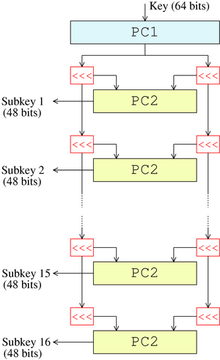Key schedule
|
|
In cryptography, the algorithm for computing the subkeys for each round in a product cipher from the encryption (or decryption) key is called the key schedule. Some ciphers have simple key schedules. For example, the block cipher TEA simply splits the 128-bit key into four 32-bit pieces and uses them repeatedly in successive rounds. RC5, Rijndael (AES), and Blowfish have much more elaborate key-schedules.
Knudsen and Mathiassen (2004) give some experimental evidence that indicate that the key-schedule plays a part in providing strength against linear and differential cryptanalysis. For toy Feistel ciphers, it was observed that those with complex and well-designed key schedules can reach a uniform distribution for the probabilities of differentials and linear hulls faster than those with poorly-designed key schedules.
See also
References
- Lars R. Knudsen and John Erik Mathiassen, On the Role of Key Schedules in Attacks on Iterated Ciphers, ESORICS 2004, pp322–334.
| Block ciphers edit (https://academickids.com:443/encyclopedia/index.php?title=Template:Block_ciphers&action=edit) |
| Algorithms: 3-Way | AES | Akelarre | Blowfish | Camellia | CAST-128 | CAST-256 | CMEA | DEAL | DES | DES-X | FEAL | FOX | FROG | G-DES | GOST | ICE | IDEA | Iraqi | KASUMI | KHAZAD | Khufu and Khafre | LOKI89/91 | LOKI97 | Lucifer | MacGuffin | Madryga | MAGENTA | MARS | MISTY1 | MMB | NewDES | RC2 | RC5 | RC6 | REDOC | Red Pike | S-1 | SAFER | SEED | Serpent | SHACAL | SHARK | Skipjack | Square | TEA | Triple DES | Twofish | XTEA |
| Design: Feistel network | Key schedule | Product cipher | S-box | SPN Attacks: Brute force | Linear / Differential cryptanalysis | Mod n | XSL Standardisation: AES process | CRYPTREC | NESSIE Misc: Avalanche effect | Block size | IV | Key size | Modes of operation | Piling-up lemma | Weak key |

